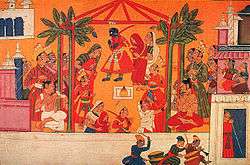Shrutakirti
In the Hindu epic Ramayana, Shrutakirti or Shrutakeerti (IAST Śrutakīrti) was a princess and daughter of King Kushadhwaja and Queen Chandrabhaga.[1] She was wife of Shatrughna, a younger brother of Rama.
| Shrutakirti | |
|---|---|
| Ramayana character | |
 Marriage of Shrutakirti and her 3 sisters | |
| In-universe information | |
| Family |
|
| Spouse | Shatrughna |
| Children | Shatrughati, Subahu |
Life
Shrutakirti's father Kushadhwaja was king of Sankasya.[2] He was brother of Mithila's king Janaka, father of Sita.[3][4] Shrutakirti also had an elder sister Mandavi.[5]
Shrutakirti was married to ayodhya's king Dasharatha's fourth and youngest son Shatrughna. They had two sons, Shatrughati and Subahu.[6] Later Shrutakirti became queen of Madhupura (Mathura) when her husband Shatrughna captured the capital after killing Lavanasura.[7]
In popular culture
| Year | TV Series | Channel | Country | Played by |
|---|---|---|---|---|
| 1987–1988 | Ramayan (TV series) | DD National | India | Poonam Shetty |
| 1997-2000 | Jai Hanuman (1997 TV series) | DD Metro | India |
Samreen Naaz |
| 2002 | Ramayan (2002 TV series) | Zee TV | India | Malini Kapoor |
| 2015–2016 | Siya Ke Ram | Star Plus | India | Tanvi Madhyan |
| 2019–2020 | Ram Siya Ke Luv Kush | Colors TV | India | Nikita Tiwari |
gollark: I mean, BF is very simple. Yet, memory-safe BF would be nightmarishly hard.
gollark: No it wouldn't. Assembly has you wildly do anything ever to registers and memory.
gollark: I regularly put up with as much as *5* seconds.
gollark: Imagine having a project containing multiple compilation units.
gollark: What if you capture the NameErrors to make lazy evaluation lazier and more inevitable?
References
- Dawar, Sonalini Chaudhry (2006). Ramayana, the Sacred Epic of Gods and Demons. Om Books International.
- GUPTA, SEEMA (2 January 2013). Ramayana. V&S Publishers. ISBN 978-93-5057-334-1.
- Tulasīdāsa's Śrī Rāmacaritamānasa: The Holy Lake of the Acts of Rāma. Motilal Banarsidass Publ. 1999. ISBN 978-81-208-0762-4.
- "Goddess Sita had three sisters, know about them". News Track. 1 May 2020.
- Prakāśa, Veda; Guptā, Praśānta (1998). Vālmīkī Rāmāyaṇa. Ḍrīmalaiṇḍa Pablikeśansa. ISBN 978-81-7301-254-9.
- Debroy, Bibek (2005). The History of Puranas. Bharatiya Kala Prakashan. ISBN 978-81-8090-062-4.
- Pargiter, F.E. (1972). Ancient Indian Historical Tradition, Delhi: Motilal Banarsidass, p.170.
This article is issued from Wikipedia. The text is licensed under Creative Commons - Attribution - Sharealike. Additional terms may apply for the media files.
.jpg)